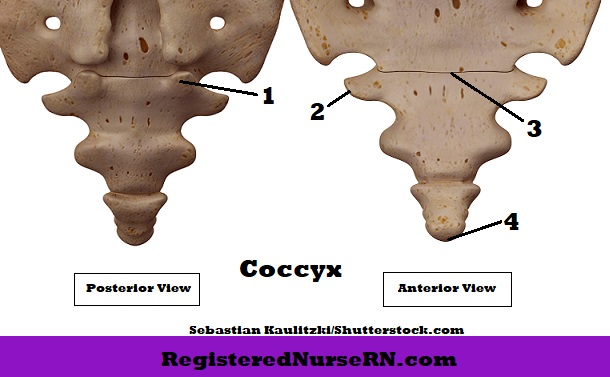Coccyx bone anatomy quiz for students taking anatomy and physiology!
In this coccyx bone anatomy quiz, you can test your knowledge of the coccyx. The coccyx bone is a vital bone that helps you with obtaining a sitting position, and it’s the location where many ligaments and tendons attach. In this quiz, you will be required to identify the coccygeal cornua, transverse process, apex and other characteristics of the coccyx bone.
Before taking this quiz, you may want to review our coccyx anatomy notes, as well as our coccyx anatomy lecture.
After taking this quiz don’t forget to check out more anatomy and physiology quizzes.
Coccyx Bone Anatomy Quiz

(NOTE: When you hit submit, it will refresh this same page. Scroll down to see your results.)
Coccyx Bone Anatomy Quiz

1. Identify structure 1 in the illustration above.
A. Coccygeal cornua
B. Base
C. Transverse process
D. Apex
The answer is A, coccygeal cornua. These articulate with the cornua of the sacrum.
2. Identify structure 2 in the illustration above.
A. Anterior surface
B. Coccygeal cornua
C. Apex
D. Transverse process
The answer is D, transverse process. Transverse means extending across, and a process is a bony projection.
3. Identify structure 3 in the illustration above.
A. Lateral border
B. Anterior surface
C. Base
D. Apex
The answer is C, base. The base of the coccyx articulates with the apex of the sacrum, forming the sacrococcygeal symphysis joint.
4. Identify structure 4 in the illustration above.
A. Apex
B. Base
C. Lateral surface
D. Posterior surface
The answer is A, apex. The apex is the inferior (bottom) portion of the coccyx bone. It allows for the attachment of the tendon of the external anal sphincter.
5. The coccyx bone is comprised of 3-5 individual bones, which often, but not always, fuse together in older adults.
A. True
B. False
The answer is A, true. While the exact number of individual coccyx bones can vary, most humans have 3-5 bones. These bones often fuse, but some can remain segmented in adults.
6. How are the coccyx bones abbreviated?
A. C1, C2, C3, C4
B. T1, T2, T3, T4
C. L1, L2, L3, L4
D. Co1, Co2, Co3, Co4
The answer is D. The coccyx bones are abbreviated as Co1, Co2, etc.
7. The coccyx bone is an important area to monitor for pressure ulcers in patients who are immobile.
A. True
B. False
The answer is A, true. The coccyx bone can cause pressure injuries in immobile patients and should be monitored.
8. How is the coccyx bone classified by anatomists?
A. Flat bone
B. Curved bone
C. Irregular bone
D. Long bone
The answer is C, irregular bone. While the coccyx bone is curved more in men than in women, no classification for a curved bone type exists. Instead, the bones of the vertebral column are classified as irregular bones.
Don’t forget to tell your friends about this quiz by sharing it your Facebook, Twitter, and other social media. You can also take more fun nursing quizzes.
*Disclaimer: While we do our best to provide students with accurate and in-depth study quizzes, this quiz/test is for educational and entertainment purposes only. Please refer to the latest NCLEX review books for the latest updates in nursing. This quiz is copyright RegisteredNurseRn.com. Please do not copy this quiz directly; however, please feel free to share a link to this page with students, friends, and others.